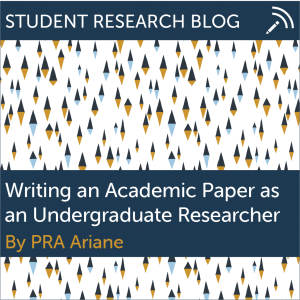 By Ariane Garrett, OUR Peer Research Ambassador
By Ariane Garrett, OUR Peer Research Ambassador
Publishing papers is the primary way that scientific knowledge is disseminated within the academic community. Therefore an essential part of becoming a successful researcher is learning how to write an academic paper. Throughout your undergraduate research career you may or may not have the opportunity to be published. Regardless, learning how academic papers are written is useful knowledge for anyone interested in pursuing a research career. Whether or not you have the opportunity to be published as an undergrad depends on a variety of factors, including the nature of your project, how often your faculty advisor publishes papers, and your particular role in the research lab. If you haven’t been published as an undergrad, no need to stress. There are many other ways your research can shine on an application.
I was tasked with writing my first paper in the spring of my junior year. As I am the primary person working on my research project, my faculty advisor expected me to write the paper by myself with his help and feedback. At first, this seemed to be a very daunting task. I had never written an entire academic paper by myself before, and I had no idea where to begin. The writing process took much longer than I expected (I didn’t finish until Fall 2019), and the paper I submitted is currently under review. In this blog post, I will share what I learned while writing my first academic paper. As a biomedical engineering major, my experience is a reflection of the norms within the engineering field. However, I hope that some of these tips will prove useful for those in all majors.
Getting Started
I began my first draft of my paper as I had begun many other papers I have written- with an introduction. When I showed my first draft to my PI, he told me that it is actually most common in the engineering field to begin writing an academic paper by constructing the figures. At first, I thought this seemed rather counterintuitive. Shouldn’t the figures be based on the writing, rather than the other way around? There are several reasons why the opposite is actually true. Firstly, the figures are the most eye-catching part of every paper and sometimes the only thing a reader will look at. In addition, many journals have figure limitations so the figures that are chosen must be carefully thought out in order to maximize their effectiveness. Lastly, constructing the figures first establishes a clear outline that you can follow as you write the rest of the paper.
Writing the Paper
Writing the actual paper is a long process that typically involves many revisions. I found it helpful to read papers from the same journal I was submitting to in order to get an idea of typical paper formats in that journal. I would also recommend seeking feedback at several stages of the writing process. Don’t wait until the entire paper is finished before showing it to your PI, instead, ask for feedback after the first draft of each section is finished. As an academic paper can have anywhere from five to hundreds of sources, I would also suggest using a citation manager as you write. This will save you from having to constantly update the sources in the paper as you add and revise.
Submitting the Paper
In my case, my PI submitted the paper and is the primary contact with the journal. However, I was expected to fully format the paper before I gave it to him to submit. If you visit the website of the journal you are submitting to, there will be details on the formatting expectations. Reformatting the entire paper after it has been written can be a lot of work, so it’s helpful to review these before you begin writing. Often, it is expected that you include a letter to the editor requesting for your paper to be considered, which you may or may not have to write depending on your PI.
After Submission
Depending on the journal, it can be up to several months before you hear back about your submission. In my case, I heard back from the reviewers about two months after submission. There were two reviewers for the paper I submitted, though this number will likely vary depending on the journal. The comments that were made were useful and provided good insight into an outsider’s perspective on my research. It is very common for journals to request revision and resubmission, so don’t expect the first paper you submit to be published!
Although writing an academic paper is challenging, I found it to be a very rewarding experience. I now appreciate how much work it takes to write a good paper and I feel like I grew as a scientific writer throughout the process. If you feel that your research deserves to be published, don’t be afraid to reach out to your PI and ask them if they think you could write a paper. Even if it is never published, writing about your research is an excellent way to become a better writer and also understand your own research area more fully.
Ariane is a senior majoring in biomedical engineering and Spanish. Click here to learn more about Ariane.